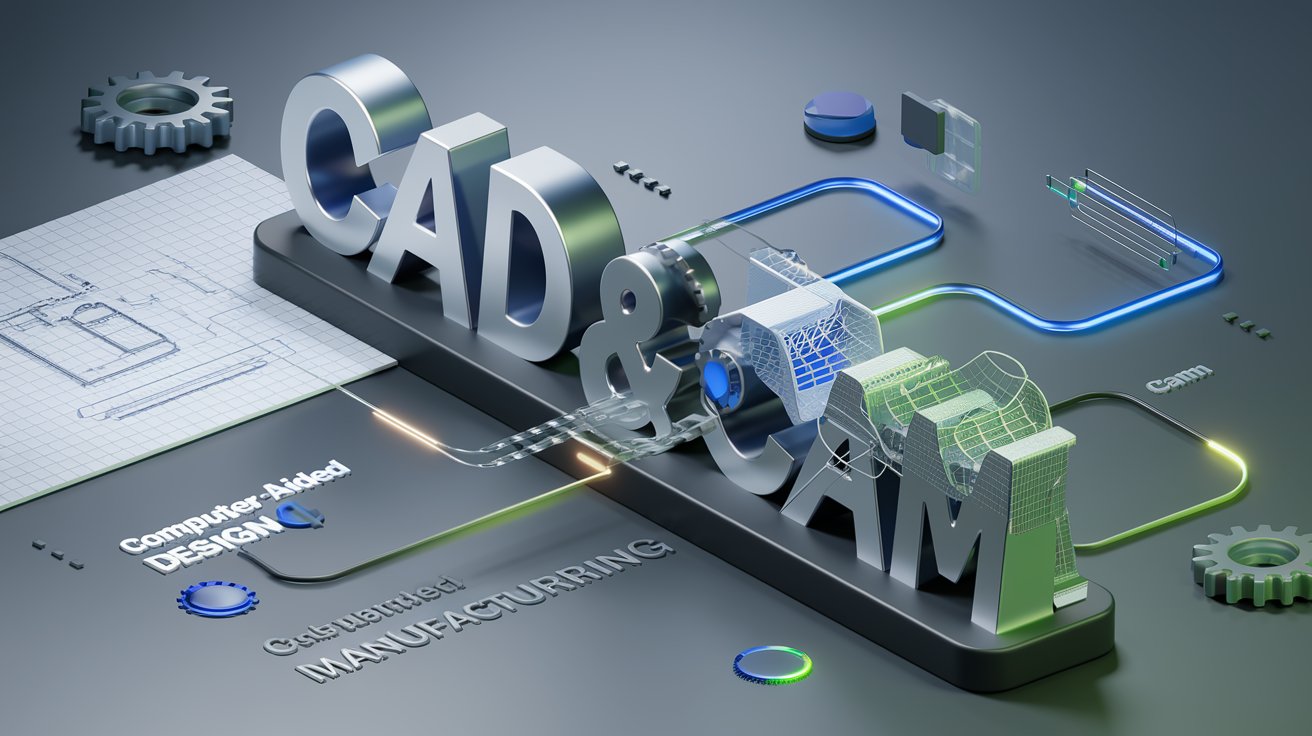In the age of digital innovation, the integration of technology into design and manufacturing processes has led to significant advancements in how products are conceptualized, developed, and produced. Two key technologies driving this transformation are Computer-Aided Design (CAD) and Computer-Aided Manufacturing (CAM). These tools have become essential in a variety of industries, from automotive and aerospace to consumer electronics and medical devices. This blog will explore what CAD and CAM are, how they work, their benefits, and why they are integral to modern design and manufacturing.
Understanding CAD: Computer-Aided Design
Computer-Aided Design, commonly known as CAD, is a technology used by engineers, architects, and designers to create precise drawings and models in both 2D and 3D. CAD software replaces traditional manual drafting with an automated, digital process that allows for greater accuracy, efficiency, and flexibility in design. The ability to visualize a design in a virtual space before it is physically created is one of the most significant advantages of CAD.
CAD software enables users to develop detailed models that can be easily modified, analyzed, and optimized. These models are not limited to simple shapes or forms but can include complex geometries and intricate details. The precision of CAD tools allows for exact measurements and specifications, reducing the risk of errors and ensuring that designs meet the required standards.
The applications of CAD are vast and varied, encompassing industries such as architecture, engineering, industrial design, automotive, aerospace, and consumer products. In architecture, for instance, CAD is used to create detailed blueprints and 3D models of buildings, enabling architects to visualize the final structure, experiment with different design elements, and make necessary adjustments before construction begins.
In mechanical engineering, CAD is used to design components and systems that will be used in machinery, vehicles, and other products. The ability to create 3D models allows engineers to test how different components will interact within a system, ensuring that they function correctly and efficiently.
Understanding CAM: Computer-Aided Manufacturing
Computer-Aided Manufacturing, or CAM, is the process of using computer software to control and manage the production of physical products. CAM software takes the designs created in CAD and translates them into instructions for manufacturing equipment, such as CNC (Computer Numerical Control) machines, 3D printers, and robotic arms.
CAM automates the manufacturing process, ensuring that products are produced with high precision and consistency. It allows manufacturers to create complex parts and assemblies that would be difficult or impossible to produce manually. By using CAM, manufacturers can achieve higher levels of accuracy, reduce production time, and minimize material waste.
The primary function of CAM is to generate toolpaths and machining instructions based on the CAD design. These toolpaths guide the movement of cutting tools, lasers, or other manufacturing equipment to shape the raw material into the desired product. CAM software can optimize these toolpaths to improve efficiency, reduce machining time, and extend the life of the tools.
CAM is widely used in industries such as aerospace, automotive, electronics, and medical devices. In aerospace, CAM is used to produce critical components for aircraft, such as turbine blades and structural elements. These parts require extremely tight tolerances and high levels of precision, which CAM can deliver. In the automotive industry, CAM is used to manufacture engine components, transmission parts, and body panels, all of which must meet strict quality standards.
How CAD and CAM Work Together
While CAD and CAM are distinct technologies, they are often used in tandem to create a seamless design-to-production workflow. The integration of CAD and CAM allows for a more efficient and streamlined process, from initial concept to final product.
The workflow typically begins with the creation of a digital model in CAD. Designers and engineers use CAD software to create a detailed representation of the product, including all dimensions, materials, and assembly instructions. This digital model serves as the blueprint for the manufacturing process.
Once the CAD model is complete, it is imported into CAM software. The CAM software then generates the necessary toolpaths and machining instructions based on the CAD design. These instructions are sent to the manufacturing equipment, such as CNC machines or 3D printers, which produce the physical product.
One of the key advantages of using CAD and CAM together is the ability to perform simulations and analyses before production begins. For example, engineers can use CAD to perform stress tests, thermal analyses, and other simulations to ensure that the design will perform as expected under real-world conditions. CAM can then simulate the machining process, allowing manufacturers to identify potential issues, such as tool collisions or material waste, before they occur on the shop floor.
This integration also enables rapid prototyping, where a digital design can be quickly transformed into a physical prototype for testing and evaluation. This iterative process allows for quick modifications and improvements to the design, ultimately leading to a better final product.
Benefits of CAD and CAM in Modern Manufacturing
The adoption of CAD and CAM technologies has brought numerous benefits to the design and manufacturing industries. These benefits include:
1. Increased Precision and Accuracy: CAD software allows designers to create highly detailed and accurate models, while CAM ensures that these designs are manufactured with precision. The result is a higher-quality product with fewer defects and inconsistencies.
2. Improved Efficiency: The automation provided by CAD and CAM reduces the time required for both design and manufacturing. CAD software streamlines the design process by allowing for easy modifications and optimizations, while CAM automates the production process, reducing machining time and increasing throughput.
3. Cost Savings: By reducing material waste, minimizing production errors, and speeding up the design-to-production process, CAD and CAM can lead to significant cost savings for manufacturers. The ability to perform simulations and analyses before production also helps prevent costly mistakes and rework.
4. Enhanced Collaboration: CAD software enables designers and engineers to collaborate more effectively by allowing them to share digital models and make real-time changes. This collaborative approach leads to better communication and alignment between teams, resulting in a more cohesive final product.
5. Flexibility and Customization: CAD and CAM technologies offer a high degree of flexibility, allowing manufacturers to produce custom products or make changes to existing designs quickly and efficiently. This flexibility is particularly valuable in industries where products must be tailored to specific customer needs or where rapid changes in market demand require quick adjustments to the production process.
6. Integration with Other Technologies: CAD and CAM are often integrated with other advanced technologies, such as 3D printing, additive manufacturing, and robotics. This integration allows for even greater innovation and efficiency in the design and manufacturing processes, opening up new possibilities for product development.
Applications of CAD and CAM Across Industries
CAD and CAM technologies are used across a wide range of industries, each with its unique requirements and challenges. Some of the key applications include:
1. Automotive Industry: In the automotive industry, CAD and CAM are used to design and manufacture a wide range of components, from engine parts to body panels. The precision and accuracy offered by these technologies ensure that all components fit together perfectly, contributing to the overall performance and safety of the vehicle.
2. Aerospace Industry: The aerospace industry relies heavily on CAD and CAM for the design and production of aircraft components, such as turbine blades, structural elements, and landing gear. The ability to create complex geometries and maintain tight tolerances is critical in this industry, where safety and performance are paramount.
3. Medical Devices: In the medical device industry, CAD and CAM are used to design and manufacture a variety of products, including prosthetics, implants, and surgical instruments. The ability to create custom, patient-specific devices is particularly valuable in this field, where precision and biocompatibility are critical.
4. Consumer Electronics: CAD and CAM play a vital role in the design and production of consumer electronics, such as smartphones, laptops, and wearable devices. These technologies allow manufacturers to create sleek, compact designs with high levels of functionality, while also ensuring that all components fit together seamlessly.
5. Architecture and Construction: In architecture and construction, CAD is used to create detailed blueprints and 3D models of buildings, bridges, and other structures. CAM can then be used to produce components, such as prefabricated panels or structural elements, that are used in the construction process.
6. Industrial Design: CAD and CAM are essential tools in industrial design, where they are used to create a wide range of products, from household appliances to furniture. The ability to create detailed models and prototypes allows designers to refine their ideas and ensure that the final product meets all functional and aesthetic requirements.
The Future of CAD and CAM
As technology continues to evolve, the future of CAD and CAM looks promising, with several trends set to shape the industry. One such trend is the increasing use of cloud-based CAD and CAM software. Cloud-based solutions offer greater flexibility and accessibility, allowing designers and engineers to work from anywhere and collaborate more easily with team members and clients.
Another trend is the integration of artificial intelligence (AI) and machine learning into CAD and CAM software. These technologies can enhance the design and manufacturing processes by automating repetitive tasks, optimizing designs, and predicting potential issues before they occur.
Additive manufacturing, or 3D printing, is also expected to play a significant role in the future of CAD and CAM. The ability to create complex, custom parts directly from a digital model opens up new possibilities for product development and production, particularly in industries such as aerospace, medical devices, and consumer electronics.
The continued advancement of virtual reality (VR) and augmented reality (AR) technologies is likely to impact CAD and CAM as well. These technologies can provide designers and engineers with immersive, interactive experiences, allowing them to visualize and manipulate digital models in ways that were previously impossible.
Conclusion
CAD and CAM are transformative technologies that have revolutionized the design and manufacturing industries. By enabling greater precision, efficiency, and flexibility, these tools have paved the way for innovation across a wide range of fields. As technology continues to evolve, the integration of CAD and CAM with other advanced technologies will further enhance their capabilities, driving the future of design and





